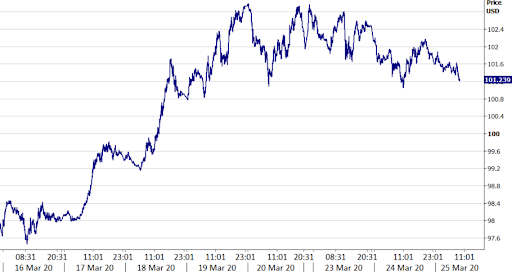Investors have breathed a sigh of relief in the past couple of days, with action from US monetary authorities returning a modicum of calm to financial markets.As expected, the Trump administration and US senators yesterday reached an agreement on the giant $2 trillion stimulus package designed to allay the impact of the COVID-19 virus on the US economy. The package will include direct payments up to as much as $1,200 to most US Americans, an increase in unemployment insurance and a $367 billion allowance for smaller businesses worst affected by the crisis. Congress is expected to vote on the bill later today.A big issue in the market at the moment is that with investors aggressively buying the greenback due to its safe-haven status, there has been a dire shortage of US dollars. We think that the aforementioned package should ease the pressure on hard dollars following a recent flurry in demand for cash. The Federal Reserve’s ‘big bazooka’ of stimulus measures announced on Monday has already begun to have a similar effect, with the dollar retracing much of its gains against its major peers so far this week, most notably the pound. We’ve also seen a near 2% move higher in EUR/USD, with the main pair now trading back above the 1.08 level. Whether this trend is sustainable in the coming days is incredibly difficult to judge.Figure 1: US Dollar Index (16/03/20 - 25/03/20) Speculation that the Fed could also be set to intervene in the market in order to weaker the rampant US dollar has also caused investors to reverse some of their long bets in favour of the greenback. Despite easing back in the past few days, the US dollar index remains around multi-year highs. There is chance that further gains for the dollar could encourage the Fed to begin selling its domestic currency holdings in order to weaken the exchange rate. While we think that this is unlikely at this stage, the mere mention of such action has already spooked some investors and caused them to reallocate their funds elsewhere. It's worth noting that FX intervention is used sparingly among major central banks, including the Fed, which has only engaged in such activities on a handful of occasions in the past few decades.
Speculation that the Fed could also be set to intervene in the market in order to weaker the rampant US dollar has also caused investors to reverse some of their long bets in favour of the greenback. Despite easing back in the past few days, the US dollar index remains around multi-year highs. There is chance that further gains for the dollar could encourage the Fed to begin selling its domestic currency holdings in order to weaken the exchange rate. While we think that this is unlikely at this stage, the mere mention of such action has already spooked some investors and caused them to reallocate their funds elsewhere. It's worth noting that FX intervention is used sparingly among major central banks, including the Fed, which has only engaged in such activities on a handful of occasions in the past few decades.
 Speculation that the Fed could also be set to intervene in the market in order to weaker the rampant US dollar has also caused investors to reverse some of their long bets in favour of the greenback. Despite easing back in the past few days, the US dollar index remains around multi-year highs. There is chance that further gains for the dollar could encourage the Fed to begin selling its domestic currency holdings in order to weaken the exchange rate. While we think that this is unlikely at this stage, the mere mention of such action has already spooked some investors and caused them to reallocate their funds elsewhere. It's worth noting that FX intervention is used sparingly among major central banks, including the Fed, which has only engaged in such activities on a handful of occasions in the past few decades.
Speculation that the Fed could also be set to intervene in the market in order to weaker the rampant US dollar has also caused investors to reverse some of their long bets in favour of the greenback. Despite easing back in the past few days, the US dollar index remains around multi-year highs. There is chance that further gains for the dollar could encourage the Fed to begin selling its domestic currency holdings in order to weaken the exchange rate. While we think that this is unlikely at this stage, the mere mention of such action has already spooked some investors and caused them to reallocate their funds elsewhere. It's worth noting that FX intervention is used sparingly among major central banks, including the Fed, which has only engaged in such activities on a handful of occasions in the past few decades. 















.svg)









.svg)




.svg)



